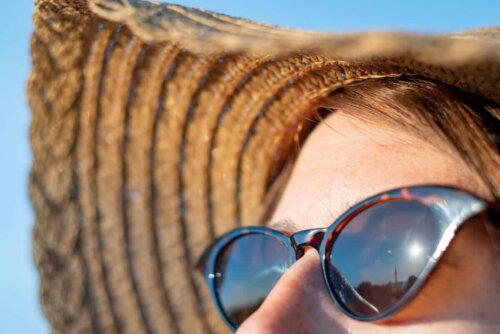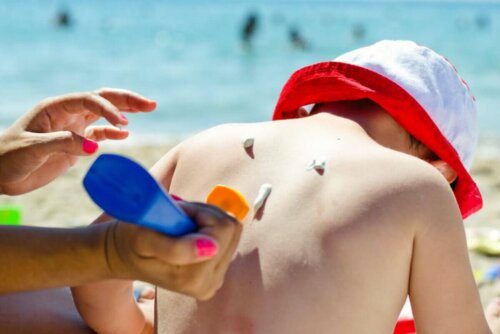The Health Effects of Solar Radiation

The sun is the closest star to Earth and has been the subject of dreams, poetry, and many scientific studies. It’s true that sunlight is a source of life and warmth. However, solar radiation doesn’t always promote good health.
The energy emitted by the sun distributes in the form of radiation, but not all of it reaches the Earth. This is because the atmosphere absorbs much of it. However, the part that reaches the earth’s surface is the cause of various conditions ranging from heat stroke to skin cancer.
What’s solar radiation like?
There are many types of solar radiation. However, only two of them are responsible for most health problems.
- Firstly, infrared radiation has low energy intensity and little power to penetrate the skin. Therefore, it isn’t usually responsible for skin problems. What’s more, it warms you up and stimulates your blood circulation. It also promotes thermoregulation and is responsible for sweating.
- Then, there’s ultraviolet radiation (UV), which barely reaches the Earth but can easily penetrate the inner layers of the skin. Depending on the type, it may either cause a simple tan or more serious injuries.

The sun and human health
Exposure to the sun promotes processes such as the synthesis of vitamin D but it can negatively affect human health in excess. The World Health Organization (WHO) has warned about the adverse effects of solar radiation.
The WHO has also indicated that some of the negative effects are:
- A greater chance of developing skin cancer
- Various degrees of sunburn
- Premature and accelerated aging as the sun’s rays can promote the formation of free radicals and cause irreversible damage to body molecules and cellular structures
- Various eye diseases, including cataracts
Other potential damage from solar radiation has to do with the ineffectiveness of the immune system:
- Alteration of the functions of antigen-presenting cells, a group of cells of the immune system that influence the proper response of the immune system.
- Increased formation of cytokines, which stimulate or decrease the response of the immune system. These mediators reduce or multiply the defense effect, according to the needs of the environment and infections by external agents.
- Changes in lymphocyte recirculation that can also affect the immune response. This is because they change the distribution routes of the white blood cells in the tissues.
- Activation of T lymphocytes, the defense cells that protect the body from infection, and help fight cancer. They cause off-site responses that could lead to pathologies if wrongly activated.
Effects of solar radiation on skin health
Skin cancer is one of the most significant health effects of solar radiation. Skin oncological pathologies have increased in the past 50 years and seem to be related to holes in the ozone layer. The function of this layer is to filter the sun’s rays.
Photoaging (premature aging of the skin) is another skin damage due to excessive sun exposure. This effect of solar radiation manifests through cutaneous elastosis in those areas that have been most exposed to the sun (face, neck, décolleté). They also lead to thickening and dryness of the skin as well as deep wrinkles.
A photoaged skin has spots and hyperpigmented areas due to an alteration of the melanocytes. The skin will be thick and rough and the pores large; this is due to a phenomenon known as hyperkeratinization.

Find out more After Sun Lotion or Moisturizer: Which is Best?
Preventing damage due to solar radiation
People respond to the sun differently. The predisposition to suffer damage will depend on the type of skin. This is why it’s important to keep your phototype in mind. For example, pale skin has less melanin and is, therefore, more sensitive to radiation than dark skin, while the latter is more prone to hyperpigmentation.
How can you prevent damage from solar radiation on your skin? In principle, you must take into account that this kind of damage is cumulative. What this means is that you’re born with a certain solar capital and you shouldn’t exceed it throughout your life. You must use sun protection products that are suitable for your skin type.
Children under the age of three shouldn’t be in the sun for long periods of time. You must take into account the recommended time slots, the geographic location, and time of year. Keep in mind that the intensity of solar rays varies depending on the altitude and the season.
We hope you’ve enjoyed this article.
All cited sources were thoroughly reviewed by our team to ensure their quality, reliability, currency, and validity. The bibliography of this article was considered reliable and of academic or scientific accuracy.
- González-Púmariega, M., Tamayo, M. V., & Sánchez-Lamar, Á. (2009). La radiación ultravioleta. Su efecto dañino y consecuencias para la salud humana. Theoria, 18(2), 69-80.
- Romero, O. C., Rojas, G. Q., Rojas, M. R., Barreto, I. R., Centeno, J., & Solís, N. P. (2009). Envejecimiento prematuro de la piel. Universitas (León). Revista Científica de la UNAN-León., 3(1), 30-33.
- Guerrero Abreu, J., & Pérez Alejo, J. L. (2006). Las radiaciones no ionizantes y su efecto sobre la salud humana. Revista Cubana de Medicina Militar, 35(3), 0-0.
- Deserio Cuesta, Julio Alberto, et al. “Identificación de variantes genéticas asociadas a la sensibilidad solar.” (2018).
- Cela, Bioquímica Eliana Maitén. Exposición cutánea a la radiación Ultravioleta. Implicancias sobre funciones del sistema inmune. Diss. Universidad de Buenos Aires, 2016.
- Gómez González, Mª. “El color y la edad de la piel: el fotoenvejecimiento.” (2017).
- Honeyman, Juan. “Efectos de las radiaciones ultravioleta en la piel.” Rev. Peru. Dermatol 12.2 (2002).
- Zapater López, María. “Radiación solar y prevención del cáncer de piel.” (2017).
- Saucedo, Gloria M. Garnacho, Rafael Salido Vallejo, and Jose Carlos Moreno Giménez. “Efectos de la radiación solar y actualización en fotoprotección.” Anales de Pediatría. Elsevier Doyma, 2020.
This text is provided for informational purposes only and does not replace consultation with a professional. If in doubt, consult your specialist.








